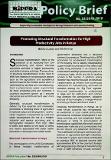| dc.date.accessioned | 2021-08-04T07:27:47Z | |
| dc.date.available | 2021-08-04T07:27:47Z | |
| dc.date.issued | 2018 | |
| dc.identifier.uri | http://repository.kippra.or.ke/handle/123456789/3070 | |
| dc.description.abstract | Structural transformation refers to the
transition of an economy from low
productivity and labour intensive
economic activities to higher productivity
and skills-intensive activities. The key driver
of structural transformation is the need to
shift from reliance on low productive sectors
such as the agricultural and subsistence
sectors towards the modern sector which is
dominated by services and manufacturing.
Such a phenomenon opens opportunities
for more productive jobs and promotes a
country's economic growth as it ensures
resources are redistributed and used more
efficiently. Generally, structural transformation is
defined by four essential and interrelated
processes: a declining share of agriculture
in national output and employment; rural-tourban
migration underpinned by rural and
urban development; the rise of a modern
industrial and service economy; and a
demographic transition from high rates
of births and deaths to low rates of births
and deaths associated with better health
standards in developed and urban areas. | en |
| dc.language.iso | en | en |
| dc.publisher | The Kenya Institute for Public Policy Research and Analysis (KIPPRA) | en |
| dc.relation.ispartofseries | PB/53/2018-2019; | |
| dc.subject | Structural transformation | en |
| dc.subject | Economic growth | en |
| dc.subject | Big 'Four' agenda | en |
| dc.subject | Industrial productivity | en |
| dc.title | Policy Brief No. 53 of 2018-2019 on Promoting Structural Transformation for High Productivity Jobs in Kenya | en |
| dc.type | KIPPRA Publications | en |
| ppr.contributor.author | Lukalo, Diana & Kiminyei, Felix | |

